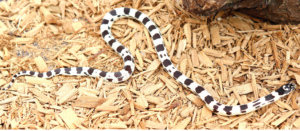The Banana King snake is one of the more commonly kept pet snakes abroad, and Animal Scene sat down with hobbyist Lendl Christopher Lin to learn more about this fascinating creature.
How did you get into keeping the Banana King snake? Is it recommended for beginners?
When I first saw a friend’s Banana King snake, I told myself, I gotta have one. Since I wanted to shift from big lizards and big snakes to smaller ones, I decided to get the Banana King Snake. In my opinion, yes, it can be recommended for beginners because of its small size. Though, I have to warn others, I have noticed that King Snakes have very strong feeding responses.
For you, what makes these particular snakes fascinating and unique? What makes them worth keeping?
I fell in love with the Banana King snake because of its colors and with its small size. I find it easy to keep and easier to handle. But what I love about this King Snake are the eyes. [These] somehow [remind] me of [those of] a cobra. I have been in love with cobras but I just don’t find it feasible for me to keep one in captivity. King snakes are called [thus] because they are also known to eat other snakes too (although I feed mine with rodents).
What are the best things you’ve learned about caring for the banana king snake, in your experience? Do their care requirements vary from those of other snakes? Do they need a lot of attention? Do they need a special diet?
The best thing I experienced with King snakes is that they don’t have any issues when it comes to feeding. It could be quite hard to find small prey items at first (if you get a hatchling) but when it grows…bigger, I can say, it’s all worth it!
Their care requirements are almost the same [as those of] other snakes. But never put—or avoid putting—two snakes in one enclosure, since King snakes will and can eat the other snake. I even heard from my friends abroad that King snakes eat other venomous snakes too.
Were there any mistakes that you made as a beginner that you feel other beginners should learn from?
When I was first got my snake years back, I made the mistake of getting the snake straight from the enclosure. Most snakes, especially when [they get] used to the enclosure, become more comfortable. And they usually anticipate us being their food source. So when I first got ahold of the snake, it was quite excited and thought I had food with me. Just like a dog waiting for his partner to give him food, all excited and crazy. So the snake ended up giving me a small bite in my arm. So [the] lesson is, always use something to pick up the snake (snake hook, tongs, or even tap them gently with newspaper).
What are the misconceptions about this animal that you would like to correct?
Well there are plenty of misconceptions about snakes in general. And it might probably take me days or weeks to enumerate and explain to them that snakes are absolutely harmless, especially when you respect their space and habits. One of my key principles is that if the snake doesn’t want or is not fit for handling, respect that. If you do, you can avoid accidents, bites, and stress for the animal. Besides, snakes that are commonly sold in the [reputable] pet industry are already captive-bred and non-venomous.

Can these creatures show affection? How do they interact with humans?
To be honest, I don’t think they can show affection like mammals do. In all honesty, in my experience, snakes doesn’t really like to be handled but [they] can tolerate handling. The main interaction snakes have with humans, in my opinion, is during feeding time. It’s the only time when snakes want something from their keeper!
What is their lifespan likely to be?
King snakes are known to have a lifespan of 15 years or more.How do you know if the banana king snake is healthy? How about the indicators when it is sick?
It is healthy when it is highly alert; its scales are smooth and well-hydrated; and [they] have a healthy body. You can see there’s something wrong if it has a discharge from the mouth and nostrils, is not alert, and not feeding. If the scales are quite loose and dry, then it could be dehydrated.
Do they require a special habitat? Are there substrates you should avoid for them?
What should they not be exposed to?I keep my King snake in a plastic [or] glass enclosure with a screen top. The substrate that I use is Snake Aspen but I am planning to change it to cypress mulch, which is commonly called ‘Forest Floor’. They shouldn’t be exposed to cedar shavings since it is known to contain or emit chemicals and is unsafe for any reptile. Your basic setup would be: an enclosure with good air circulation, a hide, a water bowl big enough for it to soak in, and a nice substrate that is reptile grade.
This appeared as “Meeting the King” in Animal Scene’s August 2015 issue.






